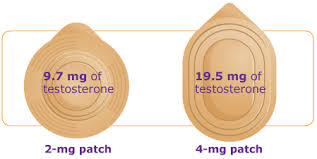How Testosterone Replacement Therapy May Help Your Impotence

Testosterone replacement therapy is becoming an increasingly popular option for treating erectile dysfunction. The increase in popularity is due in part to the new forms that are available. In the past, your only choice was injections if you wanted to try testosterone for erectile dysfunction. Today, there are more choices.
On this page, you will find an overview of the new forms, along with information that will help you decide if testosterone replacement therapy is the right choice for you.
Forms of testosterone supplements
In addition to the injections that have been available for years, there are patches, gels and even implants. Here’s a brief description of each form.
Two types of patches are available: the skin patch and the mouth patch. The skin patch or “transdermal” patch is similar to the nicotine patch that helps smokers quit. The hormone is released gradually into the bloodstream through the skin. The patch must be replaced every day to maintain the desired testosterone level.
The mouth patch is called “Striant”. It is a small tablet-shaped patch that sticks to the upper gums. Although the mouth patch must be replaced twice a day, there may be a benefit in that the hormones are more readily absorbed through the tissues of the mouth.
Several brands of testosterone gel are available. The hormones in the gel are absorbed through the skin as they are with the patches. The gel is applied once a day. The amount of gel to use (the dosage) is determined by your doctor. Most brands come with a pump that delivers the correct amount, so that you don’t have to guess about how much gel to use.
The implants are similar in design to the implanted birth control method used by some women. Pellets are inserted beneath the skin into the soft tissue, usually under your arm. The testosterone is released slowly into the bloodstream in a time-released manner. The implants are typically replaced 3 times per year, every 4 months or so.
Testosterone pills are also available but are not generally recommended because of an increased risk of side effects, including liver damage.
Symptoms of low T and replacement therapy benefits
While you might think that most men take testosterone for ED, there are other bothersome symptoms. Other than ED, the symptoms that may be relieved with testosterone replacement therapy include:
· Difficulty concentrating
· Depression
· Irritability
· Mood swings
· Migraine headaches
· Fatigue
· Lack of energy
· Memory problems
· Weight gain – increase in body fatness
· Loss of muscle tone
· Low self-esteem
· Low sex drive
While the last symptom may be related to erectile dysfunction, it is sometimes a separate issue. A man may have the desire but have difficulty achieving or maintaining an erection; that’s basically the definition of erectile dysfunction. With low sex drive, there is less desire to be “romantic”.
Benefits of Testosterone Replacement Therapy
The benefits vary from one man to the next. It can take up to four weeks to notice a difference, depending on the form of the therapy. It takes time for testosterone levels to build up in the bloodstream.
Choosing testosterone for erectile dysfunction alone is not a fast acting solution. It’s not like Viagra or other medications described on this website.
On the other hand, Viagra and other fast-acting medications cannot address the other symptoms caused by low testosterone. In addition to relieving those symptoms, doctors believe that the therapy increases muscle mass and bone density, reducing the risk of osteoporosis.
There may also be a benefit related to type II diabetes. Some studies have shown that testosterone replacement therapy improves insulin sensitivity, allowing your body to burn glucose for energy more efficiently and possibly reducing your risk of type II diabetes. Benefits of testosterone for ED have also been seen in men with existing diabetes.
Are there any risks of testosterone for ED?
The long-term risks are unknown, as there have been no trials following men who use the therapy year after year. There may be an increased risk of enlarged prostate and prostate cancer, because testosterone naturally stimulates the growth of prostate tissue and also drives the growth of some forms of cancer. There may also be an increased risk of blood clots because the hormone increases the production of red blood cells, which basically thickens the blood.
Certain conditions may be worsened by testosterone replacement therapy. Sleep apnea is an example. Men with known heart disease or congestive heart failure should not take testosterone supplements.
So what's the bottom line?
Choosing testosterone for ED is a personal decision. If you have other symptoms, such as low energy levels or memory problems, this may be the right choice for you. Your doctor can do a blood test to find out whether or not low testosterone is your problem.
If your blood level is not low, there are plenty of other options for treating erectile dysfunction. You can learn about them on other pages of this website. You’ll be happy to know that most men find a solution. It may take a little trial and error but it’s worth your time to keep trying.
read about other new impotence treatments
Featured Men's Health Supplement

Check out Total Balance Men's Premium today!
Search Our Site
| advanced |
Popular Articles
Alcohol and ED
What causes impotence?
Best Natural Treatments
Non-Drug Options
Vitamins that can help
Foods that can cause ED
Erectile Dysfunction Age


